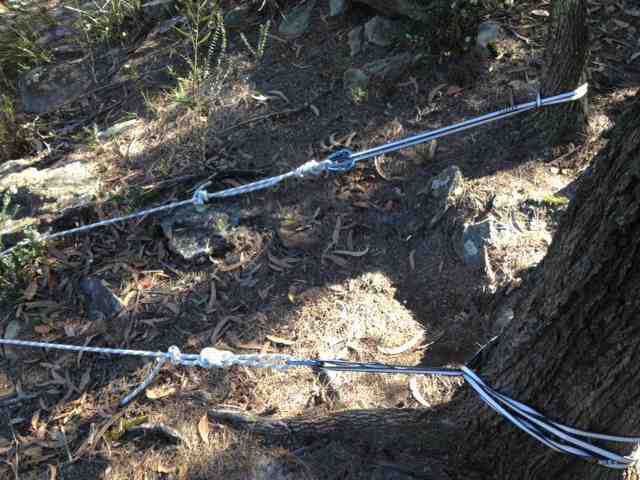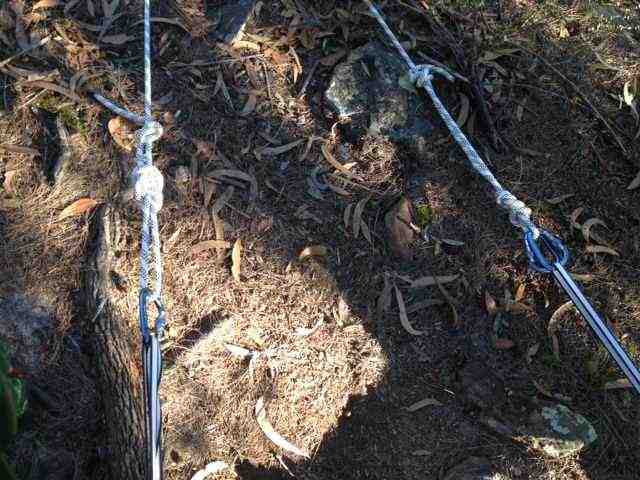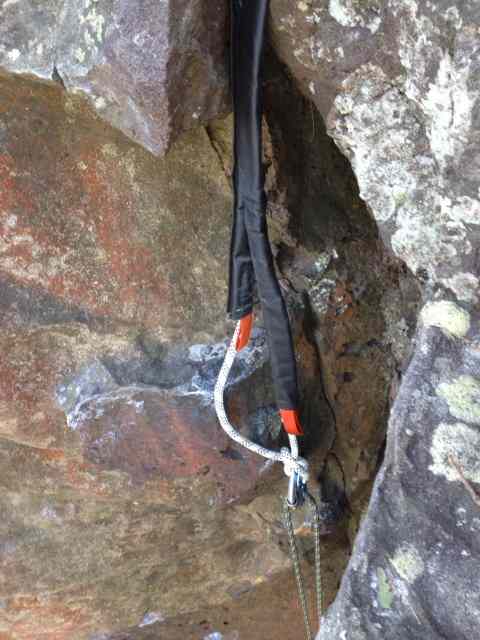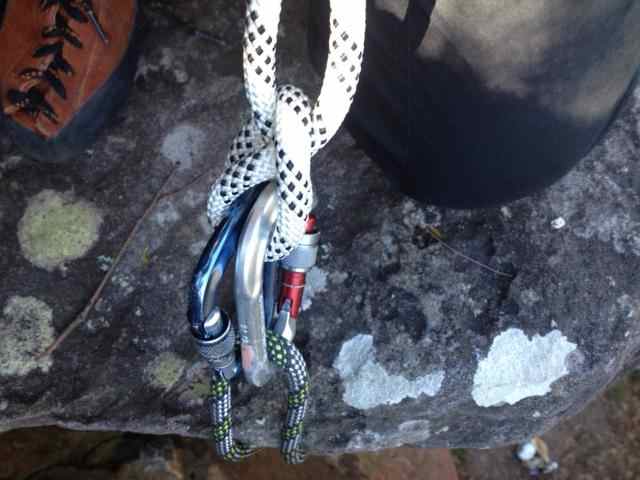Sponsored By
ROCK
HARDWARE
Chockstone Photography
Australian Landscape Prints |
 Chockstone Forum - Gear Lust / Lost & Found
Chockstone Forum - Gear Lust / Lost & Found
Rave About Your Rack Please do not post retail SPAM.
| Author |
|
|||||
6:01:02 PM |
Hello! I'm newish to outdoor climbing and am learning how to set up TR anchors, is it possible for anyone to gaze over my top rope anchors (using trees) and offer feedback? Have I done it safely? The Green rope is my climbing rope. Any thoughts would be hugely appreciated, if you were to suggest a way of making this a better set up, what would it be?     |
|||||
6:47:28 PM |
A couple of points: If you use trees as anchors, 1 make sure they are bomber and 2 use something to protect the tree from the slings (to stop ring barking) In picture 3 each arm of the anchor don't seem to be equalised In picture 4 the master point where the climbing rope goes through is set too far back and the climbing rope will rub on the cliff edge also in pic 4, i'm not sure what knot you have used to attach the anchor rope to the master point biners, but I would use two fig 8 on the bight with a small amount of slack between them. this essentially makes each arm of the anchor independent of the other hope this helps |
|||||
8:13:26 PM |
Only thing I could add is that you don't really need 2 biners to attach the static rope (?) to the sling (pics 1&2)... :) Edited for clarity and spelling |
|||||
8:15:37 PM |
On 14/08/2013 pharmamatt wrote: >In picture 4 the master point where the climbing rope goes through is >set too far back and the climbing rope will rub on the cliff edge Pretty sure they have pulled the master point up over the edge to get a close up. |
|||||
8:15:57 PM |
Thank you. Roger that, solid trees plus tree protection. I lifted the ropes up to take pics hence why they didn't look equalised and they look set back. Re: using 'two fig 8 on the bight' Do you mean tie two of these knots ( http://www.youtube.com/watch?v=_DPYEPxtjF0 ) one for each arm of the anchors, and then loop both through the biners? Thanks heaps for your help. |
|||||
8:51:13 PM |
Overall what you have is relatively safe and works for its intended purpose. If you want pedantic further critique / refinement then you could consider the following points. You used a static rope for the top-rope anchor lines. This is good as they generally withstand abrasion better (than dynamic), and don't stretch excessively, so that knot points tend to remain at the locations they are set. The big tree anchor should be the primary anchor and the little tree best considered as a backup anchor. This is important in as much as I note you have doubled krabs on the small tree sling for redundancy, but not on the large tree sling, and I would have done this the other way around. Having said that, M75 is correct in the fact you don't need two at that point. and the excess locking krab would be better used to avoid girth hitching your main-anchor sling, ~> see next point... I note your tree slings are girth hitched to themselves around their respective anchors. I would have used a locking krab to connect both ends of the sewn-sling after passing it around the tree, as girth hitching slings decreases their rated strength, but an open loop connected as suggested retains almost all of the slings strength. The angle between the anchors is well within acceptable limits, ie it looks to be about 30° which is good. Simplistic note: 60° is OK and 90° acceptable, but anything over that rapidly (greater as the angle increases), trends to putting a lot of the loading equally onto both anchors instead of sharing that load. Your fig-8 knots are well dressed (good), and have long tails (good), along with stopper knots (also good). You used rope protectors, good. It is not evident in the photos, but another useful tip with rope protectors, is to tie a short prusik cord to the end of the rope protector sleeve, and prusik or clove hitch it, to the rope it is protecting. This keeps it at the desired location by preventing it sliding down the rope. Like pharmamatt suggests, I would have used a double fig-8 on the bight with a small bit of slack between them to retain redundancy as the end knot, instead of a clove hitch, but this is only personal preference. The clove hitch although safe enough; as your photos indicate, is trying to split/spread (with loading), rather than cinch up snug, which kind of defeats the purpose of using that knot in that application. To illustrate my point, imagine if one strand of the setup was to fail, ... the loose(ning) clove hitch would allow slippage on the remaining strand under load (till friction causes it to lock down), where a cinched tight clove hitch would still have integrity... Your use of doubled and opposed* locker krabs as the top-rope point is a good practise. (*I usually invert one so that even if it flips over, the gates are still opposed). |
|||||
9:02:01 PM |
On 14/08/2013 misszeus wrote: >Re: using 'two fig 8 on the bight' >Do you mean tie two of these knots ~ fig-8 'bunny ears' (snip) No, although that is also acceptably safe for the application. Greater redundancy would be to tie a directional fig-8 (facing towards the anticipated loading in one strand at the desired end point, then on the remaining strand tie another similar directional fig-8, but with a small amount of rope remaining between the two knots. The fact the knots are separated is what provides the redundancy. |
|||||
9:21:09 PM |
Thank you very much :) | |||||
10:00:13 PM |
Why not just tie the two ends of the rope around the two trees directly rather than the sling, biners, knots combo? Seems like over-complexity for nil gain. | |||||
10:02:50 PM |
What an excellent thread - the trolls must have been watching Offspring or Chasers? |
|||||
10:21:15 PM |
On 14/08/2013 nmonteith wrote: >Why not just tie the two ends of the rope around the two trees directly >rather than the sling, biners, knots combo? Seems like over-complexity >for nil gain. Because misszeus is prolly a budding tradster still using a 50 m cord, so doesn't want her toprope anchor, half way between the edge and the main anchor? |
|||||
8:36:46 AM |
>Why not just tie the two ends of the rope around the two trees directly rather than the sling, biners, knots combo? Seems like over-complexity for nil gain. Noted, good point. My static rope wasn't long enough to reach the edge of the cliff (if tied directly to the trees) so we used slings to gain extra length. Am using a 60m dynamic rope for climbing but was worried about it wearing on the rock if up too high. |
|||||
8:58:07 AM |
My thoughts: - If you could avoid using slings and biners around the tree, it would make it simpler and with less points to fail, but if you needed the length of the slings then what you did was fine. - If you could avoid girth hitching the slings, then this would be better, but again, if you needed the length then I'm sure the strength reduction wouldn't be an issue on a TR setup. The closer sling looks like it has been doubled and then girth hitched, if so, don't bother with the girth hitch, and you'll get some more length, and keep the sling stronger. - As others have said, two, independant fig-8 on a bights, each with both biners clipped through them would be preferable for the master point. - For the masterpoint biners (ie where the dynamic runs), I would have them spun around 180 degs. Currently they are opposite and opposed, which is great, but if you had it so the "fat" end of the biner was down, then if the movement of the biners tried to wiggle the screw gates, they would wiggle towards being more locked and closed, rather than wiggle towards unscrewing themselves, and leaving the gates potentially able to open. A small thing, but it is best practice. - Most importantly, as others have said, the anchor is only as good as the gear (or in this case, the trees), so closely inspect them with a critical eye, keep the slings/rope down as low as you can to the ground to reduce leverage, and use padding to protect the tree for future generations. |
|||||
9:07:17 AM |
On 14/08/2013 IdratherbeclimbingM9 wrote: >Greater redundancy would be to tie a directional fig-8 (facing towards the anticipated loading in one strand at the desired end point, then on the remaining strand tie another similar directional fig-8, but with a small amount of rope remaining between the two knots. The fact the knots are separated is what provides the redundancy. I'm not sure why you'd use directional figure 8s for this application. I'd just use figure 8s on the bight with slack between them. Something like this (though with shorter knots and more slack between them):  In a similar vein (pad the trees though):  One last thing, if the biners sit flat against the cliff, you want the strand the climber is on towards the rock. If they are on the one away from the rock, when they weight the system it jams the biners against the cliff and can prevent the rope moving which makes lowering difficult. |
|||||
9:11:06 AM |
For the masterpoint krabs I would prefer to use some form of auto-locking krabs rather than unscrew-gates. Apart the risk of forgetting to lock them, standard screwgates can tend to undo over time as they move around. Doing them up really tight isn't a guarantee, though it can mean you'll need pliers to undo them at the end of the day. | |||||
9:22:18 AM |
On 15/08/2013 ajfclark wrote: >I'm not sure why you'd use directional figure 8s for this application. > I'd just use figure 8s on the bight with slack between them. Both work more than well enough in this (a top-rope) application. The nuances of the directional version only provide benefits for certain circumstances, the main one being slightly stronger once under load, due less tendency to 'split' the knot. ... and it would seem that the critiques are aiming at having a 'perfect (overkill strength, redundancy, relative simplicity, etc) set-up in an ideal world', so I ran with that flavour! Your posted photo and diagram of setup, are good additions to this thread. |
|||||
9:24:19 AM |
Another thing is to not have your masterpoint krabs locked in against each other by clipping them into the same knot, as you have done with the clove hitch. When locked together the two krabs will interact and that can lead to unpredictable behaviour. Keep it simple and minimise the contact between the krabs. ajfclark's diagram above shows a better way, with the krabs on separate knots. | |||||
12:34:48 PM |
On 15/08/2013 kieranl wrote: >it can mean you'll need pliers to undo them at the end of the day Forgot the pliers? Clip the offending old biner between your belay biner and that of the next most attractive member of the party. Appose groins, both lean back and the biner should unscrew quite easily. |
|||||
1:46:58 PM |
Orienting screwgate carabiners so that the gate faces down (when hung vertically the gate hinge is at the top) will stop the screwgates rattling undone. It only takes a slight incline in the carabiner to achieve this. |
| There are 19 messages in this topic. |
Home | Guide | Gallery | Tech Tips | Articles | Reviews | Dictionary | Forum | Links | About | Search
Chockstone Photography | Landscape Photography Australia | Australian Landscape Photography | Landscape Photos Australia
Please read the full disclaimer before using any information contained on these pages.
Australian Panoramic |
Australian Coast |
Australian Mountains |
Australian Countryside |
Australian Waterfalls |
Australian Lakes |
Australian Cities |
Australian Macro |
Australian Wildlife
Landscape Photo |
Landscape Photography |
Landscape Photography Australia |
Fine Art Photography |
Wilderness Photography |
Nature Photo |
Australian Landscape Photo |
Stock Photography Australia |
Landscape Photos |
Panoramic Photos |
Panoramic Photography Australia |
Australian Landscape Photography |
High Country Mountain Huts |
Mothers Day Gifts |
Gifts for Mothers Day |
Mothers Day Gift Ideas |
Ideas for Mothers Day |
Wedding Gift Ideas |
Christmas Gift Ideas |
Fathers Day Gifts |
Gifts for Fathers Day |
Fathers Day Gift Ideas |
Ideas for Fathers Day |
Landscape Prints |
Landscape Poster |
Limited Edition Prints |
Panoramic Photo |
Buy Posters |
Poster Prints
